Review of Shale Oil and Gas Refracturing: Techniques and Field Applications
Abstract
:1. Introduction
2. Basic Conditions of Refracturing
2.1. Well and Layer Selection Conditions
- (1)
- There are sufficient remaining reserves around the candidate well with a high initial production.
- (2)
- The well structure meets the requirements of refracturing construction, the wellbore diameter allows the running of fracturing tools, and the quality of production casing cementing can ensure the isolation between layers. Pumped bridge plug perforation completion is the best way to complete refracturing candidate wells due to the full diameter of the horizontal section and annular cement isolation.
- (3)
- The initial productivity of candidate wells is lower than expected due to non-reservoir factors such as the initial fracturing design and the construction technology, such as an imperfect fracturing fluid system, a small amount of sand added to fracturing, and excessive fracturing stage spacing and cluster spacing.
- (4)
- Due to the improper selection of nozzle size in the production process, the production decline is too fast, resulting in the premature closure of formation cracks.
- (5)
- Due to the sand and scale formation of the wellbore during the production process, the subsequent production capacity is lower than expected.
- (6)
- The candidate well has a reasonable distance from the adjacent well, there is no serious pressure collusion with the adjacent well, and the horizontal section does not cross the fault.
- (7)
- Before the infill well is drilled but not yet fractured, the mother well should be refractured first to restore the formation pressure around the mother well, and then the infill well should be fractured to reduce the phenomenon of the asymmetric expansion of the infill well fracture to the side of the mother well due to the pressure shortfall of the mother well, which can not only increase the output of the infill well but also protect the output of the mother well [13].
2.2. Well and Layer Selection Method
- (1)
- The subjectivity of the field experience method is strong, which can easily lead to deviation in the evaluation results.
- (2)
- The fuzzy comprehensive evaluation method selects refracturing wells mainly through fuzzy identification, membership degree theory, and the European proximity degree between each well and refracturing ideal wells. The fuzzy comprehensive evaluation method also relies on the accumulation of expert experience and has a certain subjectivity.
- (3)
- The neural network method involves complex hyperparameter adjustment and its training process has high requirements on field data, and a large number of refracturing wells with different effects need to be selected as learning and training samples. It is difficult to establish a reliable neural network model if there are few pre-fracturing wells in a target block.
- (4)
- The reservoir numerical simulation rule is based on the static and dynamic data of the gas reservoir after the initial fracturing, simulates the influence of various factors on the refracturing effect, and adopts mathematical statistical methods to make refracturing decisions. The reservoir numerical simulation method has very high requirements for reservoir geological modeling and involves complex mathematical calculation, which leads to high time costs and makes it difficult to meet the needs of rapid on-site evaluation.
3. Refracturing Process
3.1. Refracturing Technique
3.1.1. General Temporary Plug Refracturing Technique
- (1)
- In-crack redirection. First, small-particle-size temporary plugging agents are injected, and, after entering a certain depth of the crack, they form a protective layer with the propping agent that can withstand a certain pressure, forcing the crack to redirect and communicate with previously unmodified areas.
- (2)
3.1.2. “Nested Casing” Refracturing Technology
- (1)
- The casing size is small, resulting in significant wellbore pressure loss and a limited construction scale.
- (2)
- The near-wellbore fracture network system causes severe fluid loss, leading to difficulties in sand addition.
- (3)
- The initial fracturing cracks can interfere with the propagation and expansion of new fracturing cracks, affecting the refracturing process.
- (4)
- The implementation cost of the process is high, and the process is complex, but it can completely seal the existing perforation holes and precisely control the initiation location and the direction of the fracturing fluid.
3.1.3. Expandable Liner Refracturing of Wellbore Technology
- (1)
- The original perforated section is isolated by the outer sealing mechanism of the liner, ensuring the internal pressure integrity of the wellbore.
- (2)
- For production zones which have been isolated by the expanded liner, refracturing operations can be conducted following the same procedures as the initial fracturing.
- (3)
- It reduces the complex operation of mechanical sealing with packers and liners, thus lowering costs.
- (4)
- It increases the available space in the wellbore after isolation, facilitating the insertion of larger fracturing equipment during the subsequent construction. The use of traditional packers and liners can significantly reduce the effective internal diameter of the wellbore for subsequent fracturing operations.
3.1.4. Slimhole Refracturing Technology
3.2. Refracturing Process Design
3.2.1. Generalized Temporary Plugging and Refracturing Process
3.2.2. “Nested Casing” Refracturing Technology Process
3.2.3. “Nested Casing” Refracturing Technology
- (1)
- Design of the External Seal Mechanism
- (2)
- Borehole Cleaning
- (3)
- Inserting and Expanding the Liner
- (4)
- Low-Pressure Testing and Drilling Accessories
- (5)
- Full-well Pressure Testing, Perforation, and Fracturing
3.2.4. Slimhole Refracturing Technology Process
4. Field Application
4.1. General Temporary Plug Refracturing
4.1.1. Haynesville Case [31]
4.1.2. Eagle Ford Case
4.1.3. Fuling Case
4.2. “Nested Casing” Refracturing
4.2.1. Haynesville Case
4.2.2. Eagle Ford Case
4.2.3. Fuling Case
4.3. Expandable Liner Refracturing of Wellbore
4.4. Slimhole Refracturing Technology
5. Economic Evaluation of Refracturing
6. Conclusions
- Wellbore conditions are fundamental to successful refracturing operations. Wells with good material foundations, a high reservoir pressure, significant reservoir damage, severe wellbore fluid accumulation, sanding and scaling issues, unreasonable initial fracturing perforation parameters, low process parameters, and high initial production rates that decline rapidly can be considered prime candidates for refracturing.
- Shale oil and gas refracturing techniques primarily encompass two categories: lumped temporary plugging refracturing and mechanical isolation refracturing (including “casing-in-casing”, expandable liners, and slimhole refracturing techniques). The specific choice of technique should be tailored to the geological, engineering, and production dynamics characteristics of the target well. The most suitable refracturing technology should be selected based on effective EUR predictions and cost accounting.
- There are significant differences in the effectiveness and economics of refracturing among different blocks in North America or between different wells within the same block. The F5-1 well is the first well in China to adopt fully domestically produced technological processes, tools, and materials for the reconstruction of the wellbore and refracturing. It holds promise for providing valuable insights for the development and production increase in aging shale gas fields in China.
Author Contributions
Funding
Data Availability Statement
Acknowledgments
Conflicts of Interest
References
- Hu, D.; Zhang, H.; Ni, K.; Yu, G. Main controlling factors for gas preservation conditions of marine shales in southeastern margins of the Sichuan Basin. Nat. Gas Ind. 2014, 34, 17–23. [Google Scholar]
- Sun, H.; Zhou, D.; Cai, X.; Wang, F.; Feng, D.; Lu, T. Progress and prospect of shale gas development of Sinope. China Pet. Explor. 2020, 25, 14–26. [Google Scholar]
- Duan, X.; Wu, J.; Zhang, X.; Hu, Z.; Chang, J.; Zhou, S.; Chen, X.; Qi, L. Progress and key issues in the study of enhanced recovery of marine shale gas in Sichuan Basin. Acta Pet. Sin. 2022, 43, 1185–1200. [Google Scholar]
- Li, Y.; He, Y.; Xiao, J.; Shi, X.; Feng, Q.; Yin, C. Optimal selection and effect evaluation of refracturing intervals of shalegas horizontal wells. Nat. Gas Ind. 2018, 38, 59–64. [Google Scholar]
- Li, Y.; Wei, C.; Qin, G.; Li, M.; Luo, K. Numerical simulation of hydraulically induced fracture network propagation in shale formation. In Proceedings of the 6th International Petroleum Technology Conference, Beijing, China, 26–28 March 2013; pp. 26–28. [Google Scholar]
- Maxwell, S.C.; Urbancic, T.I.; Steinsberger, N.; Zinno, R. Micro-seismic imaging of hydraulic fracture complexity in the Barnett shale. In Proceedings of the SPE Annual Technical Conference and Exhibition, San Antonio, TX, USA, 29 September–2 October 2002. [Google Scholar]
- Meyer, B.R.; Bazan, L.W. A discrete fracture network model for hydraulically-induced fractures: Theory, parametric and case studies. In Proceedings of the SPE Hydraulic Fracturing Conference and Exhibition, The Woodlands, TX, USA, 24–26 January 2011; pp. 24–26. [Google Scholar]
- Mittal, R.; Oruganti, Y.D.; McBurney, C. Re-fracturing simulations: Pressure-dependent SRV and shear dilation of natural fractures. In Proceedings of the Unconventional Resources Technology Conference, San Antonio, TX, USA, 20–22 July 2015; pp. 20–22. [Google Scholar]
- Xiao, J.; You, Y.; Zhu, H.; Tang, X.; Zhang, F.; Liu, W. Key technologies for development adjustment well fracturing in Chongqing Fuling National Shale Gas Demonstration Area. Nat. Gas Ind. 2022, 42, 58–65. [Google Scholar]
- Barree, R.D.; Miskimins, J.L.; Svatek, K.J. Reservoir and completion considerations for the refracturing of horizontal wells. SPE Prod. Oper. 2018, 33, 1–11. [Google Scholar] [CrossRef]
- Oruganti, Y.; Mittal, R.; Mcburney, C.J.; Rodriguez, A. Re-fracturing in Eagle Ford and Bakken to increase reserves and generate incremental NPV: Field study. In Proceedings of the SPE Annual Technical Conference and Exhibition, Houston, TX, USA, 28–30 September 2015; p. SPE 173340. [Google Scholar]
- Yang, Z.; Li, Y.; Li, X.; Li, C. Key technology progress and enlightenment in refracturing of shale gas horizontal wells. J. Southwest Pet. Univ. 2019, 41, 75–86. [Google Scholar]
- Guang, X.; Wang, M. Refracturing key technologies of shale oil and gas in North America and the suggestions. Oil Drill. Prod. Technol. 2019, 41, 224–229. [Google Scholar]
- Jiang, T. A fuzzy method for selecting well and formation in refracting. Oil Drill. Prod. Technol. 1997, 19, 60–62. [Google Scholar]
- Zhou, Z.; Ma, H.; Xu, W.; Yu, X.; Liu, W.; Li, X. Appling fuzzy comprehensive judge method to identify deficient returing well. Math. Pract. Theory 2009, 39, 80–86. [Google Scholar]
- Zhang, W.; Liu, J.; Zhao, X.; Yang, J. Study on well selection and layer selection in Hujianshan Chang 4+5 reservoir by refracturing. Chem. Eng. Equip. 2015, 10, 132–137. [Google Scholar]
- Du, W. Artificial neural network method for well and layer selection in refracturing. Drill. Prod. Technol. 2003, 4, 117–118. [Google Scholar]
- Cheung, C.M.; Goyal, P.; Tehrani, A.S.; Prasanna, V.K. Deep Learning for Steam Job Candidate Selection. In Proceedings of the SPE Annual Technical Conference and Exhibition, San Antonio, TX, USA, 9–11 October 2017; p. SPE187339MS. [Google Scholar]
- Denney, D. Artificial Neural Networks Identify Restimulation Candidates. J. Pet. Technol. 2000, 52, 44–45. [Google Scholar] [CrossRef]
- Udegbe, E.; Morgan, E.; Srinivasan, S. From Face Detection to Fractured Reservoir Characterization: Big Data Analytics for Restimulation Candidate Selection. In Proceedings of the SPE Annual Technical Conference and Exhibition, San Antonio, TX, USA, 9–11 October 2017; p. SPE187328-MS. [Google Scholar]
- Liu, Z. Method for selecting refracturing wells in low permeability sandstone reservoirs based on pearson correlation coefficient. Pet. Geol. Recovery Effic. 2022, 29, 140–144. [Google Scholar]
- Cao, X. Application of temporary plug refracturing technology in oilfield. China Pet. Chem. Ind. Stand. Qual. 2022, 42, 11–14. [Google Scholar]
- Berchenko, I.; Detournay, E. Deviation of hydraulic fractures through poroelastic stress changes induced by injection and pumping. Am. Rock Mech. Assoc. 1997, 34, 1009–1019. [Google Scholar] [CrossRef]
- Mahmood, M.N.; Guo, B. An analytical method for optimizing fracture spacing in shale oil reservoirs. In Proceedings of the SPE Liquids-Rich Basins Conference—North America, Odessa, TX, USA, 7–8 November 2019; p. SPE197083. [Google Scholar]
- Huo, Y.; Jiang, H. A preferred method for gas well refracturing well based on BP neural network. Nat. Gas Geosci. 2020, 31, 552–558. [Google Scholar]
- Pankaj, P.; Gakhar, K.; Lindsay, G. When to refrac? Combination of reservoir geomechanics with fracture modeling and reservoir simulation holds the answer. In Proceedings of the SPE Asia Pacific Oil & Gas Conference and Exhibition, Perth, Australia, 25–27 October 2016; p. SPE182161. [Google Scholar]
- Ren, W.; Li, G.; Tian, S.; Sheng, M.; Geng, L. Analytical modelling of hysteretic constitutive relations governing spontaneous imbibition of fracturing fluid in shale. J. Nat. Gas Sci. Eng. 2016, 34, 925–933. [Google Scholar] [CrossRef]
- Sun, X. A refracturing candidate selection method based on fuzzy comprehensive evaluation. Sci. Technol. Innov. Her. 2008, 4, 80–81. [Google Scholar]
- Gumus, A.T.; Yayla, A.Y.; Celik, E.; Yildiz, A. A combined fuzzy-ahp and fuzzy-gra methodology for hydrogen energy storage method selection in Turkey. Energies 2013, 6, 3017–3032. [Google Scholar] [CrossRef]
- Grieser, B.; Calvin, J.; Dulin, J. Lessons learned: Refracs from 1980 to present. In Proceedings of the SPE Hydraulic Fracturing Technology Conference and Exhibition, The Woodlands, TX, USA, 9–11 February 2016; p. SPE179152. [Google Scholar]
- Cadotte, R.J.; Crowley, Z.; Elbel, B. Evaluation of cement-isolated casing liner and degradable particulate diverter refracturing treatments in the Haynesville shale. In Proceedings of the SPE Hydraulic Fracturing Technology Conference and Exhibition, The Woodlands, TX, USA, 23–25 January 2018; p. SPE189843. [Google Scholar]
- Allison, D.B.; Curry, S.S.; Todd, B.L. Restimulation of wells using biodegradable particulates as temporary diverting agents. In Proceedings of the Canadian Unconventional Resources Conference, Calgary, AB, Canada, 15–17 November 2011; p. SPE149221. [Google Scholar]
- Xiao, B.; Li, S.; Jiang, T.; Gao, D.; Bian, X. Research progress on temporary-plugging refracturing technology for shale gas wells. Sci. Technol. Eng. 2020, 20, 9707–9715. [Google Scholar]
- Tian, G. Sinopec shale gas horizontal well was successfully refractured for the first time. Nat. Gas Ind. 2017, 37, 98. [Google Scholar]
- Dong, S.; Jing, C.; Song, W.; Yang, L.; Luo, Y.; Duan, Y. Development and enlightenment of refracturing technology for horizontal shale gas wells in North America. Drill. Prod. Technol. 2022, 45, 98–102. [Google Scholar]
- Teng, C. Enventure GT introduces expandable liner refracturing technology. Pet. Drill. Tech. 2016, 44, 98. [Google Scholar]
- Luo, Y. Application Research of Expandable Tube Technology in Refracturing; China University of Petroleum: Beijing, China, 2021. [Google Scholar]
- Hlidek, B.; MacDonald, D.; Gee, C. Slimhole refracturing case studies and experience utilizing mechanical isolation for effective refracture treatments. In Proceedings of the SPE Low Perm Symposium, Denver, CO, USA, 5–6 May 2016; p. SPE180236. [Google Scholar]
- Yi, S.; Sharma, M. A model for refracturing operations in horizontal wells employing diverting agents. In Proceedings of the SPE Asia Pacific Hydraulic Fracturing Conference, Beijing, China, 24–26 August 2016; p. SPE181795. [Google Scholar]
- Morales, A.; Zhang, K.; Gakhar, K.; Porcu, M.M.; Lee, D.; Shan, D.; Malpanj, R.; Pope, T.; Sobernheim, D.; Acock, A. Advanced modeling of interwell fracturing interference: An Eagle Ford Shale oil study-refracturing. In Proceedings of the SPE Hydraulic Fracturing Technology Conference, The Woodlands, TX, USA, 9–11 February 2016; p. SPE179177. [Google Scholar]
- Agharazi, A.; Kashikar, S. A geomechanical study of refracturing based on microseismic observations-case study of Haynesville and Eagle Ford wells. In Proceedings of the SPE/AAPG/SEG Unconventional Resources Technology Conference, San Antonio, TX, USA, 1–3 August 2016; p. URTEC-2435484. [Google Scholar]
- Elbel, B.; Modeland, N.; Habachy, S.; Nabors, J.; Brannon, R. Evaluation of a casing-in-casing refracturing operation in the Burleson county Eagle Ford formation. In Proceedings of the IADC/SPE Drilling Conference and Exhibition, Fort Worth, TX, USA, 6–8 March 2018; p. SPE189644. [Google Scholar]
- Liu, Y.; Li, Y.; Ming, Y.; Xiao, J.; Han, R.; Wang, Z.; Zhang, J.; Wu, C. First successful application of casing in casing CiC refracturing treatment in shale gas well in China: Case study. In Proceedings of the Abu Dhabi International Petroleum Exhibition & Conference, Abu Dhabi, United Arab Emirates, 15–18 November 2021; p. SPE208060. [Google Scholar]
- Luo, Y.; Zhang, Q.; Guo, H.; He, F. Technology status and development for ESeal RF liner. Oil Field Equip. 2019, 48, 81–85. [Google Scholar]
- Mary, G.; Joshua, B.; James, P.; Pettigrew, S.; Elvig, K. An Eagle Ford case study: Improving an infill well completion through optimized refracturing treatment of the offset parent wells. In Proceedings of the SPE Hydraulic Fracturing Technology Conference and Exhibition, The Woodlands, TX, USA, 5–7 February 2019; p. SPE194374. [Google Scholar]
- Gomaa, A.M.; Nino-Penaloza, A.; Mccartney, E.; Mayor, J. Engineering solid particulate diverter to control fracture complexity. In Proceedings of the SPE Hydraulic Fracturing Technology Conference, The Woodlands, TX, USA, 9–11 February 2016; p. SPE179144. [Google Scholar]
- Liu, Y.; Ming, Y.; Zhang, X.; Bian, X.; Zhang, C.; Wang, H. “Casing in casing” mechanical isolation refracturing technology in Fuling Shale Gas Wells. Pet. Drill. Tech. 2022, 50, 86–91. [Google Scholar]
- Cadotte, R.J.; Elbel, B.; Modeland, N. Unconventional multiplay evaluation of casing-in-casing refracturing treatments. In Proceedings of the SPE International Hydraulic Fracturing Technology Conference and Exhibition, Muscat, Oman, 16–18 October 2018; p. SPE191451. [Google Scholar]
- Amrut, A.; Adebayo, O.; Carl, K.; Sunil, L.; Lisset, S. Refracturing technology restores profitability of older unconventional wells in Southeast New Mexico. In Proceedings of the SPE Hydraulic Fracturing Technology Conference and Exhibition, The Woodlands, TX, USA, 5–7 February 2019; p. SPE194372. [Google Scholar]

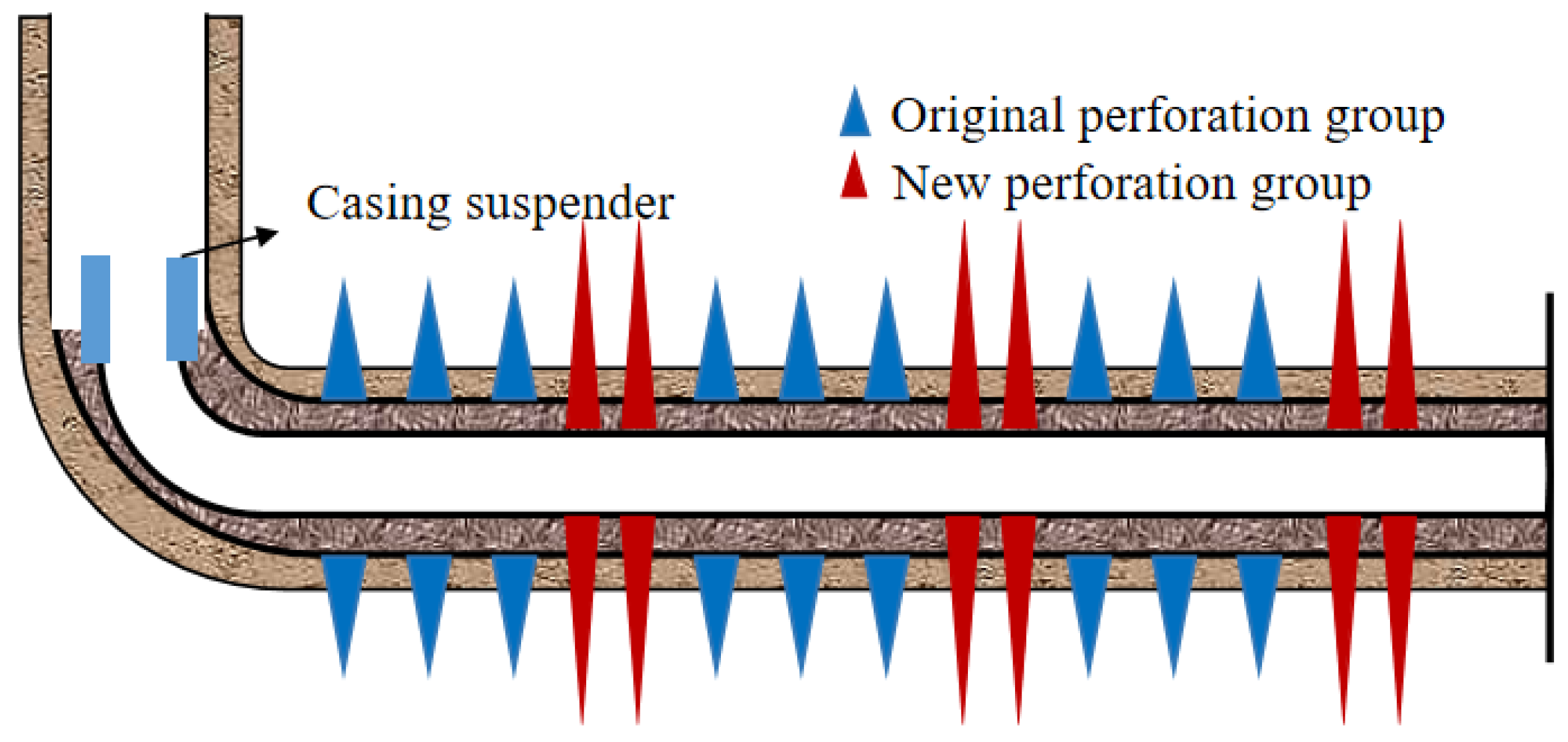
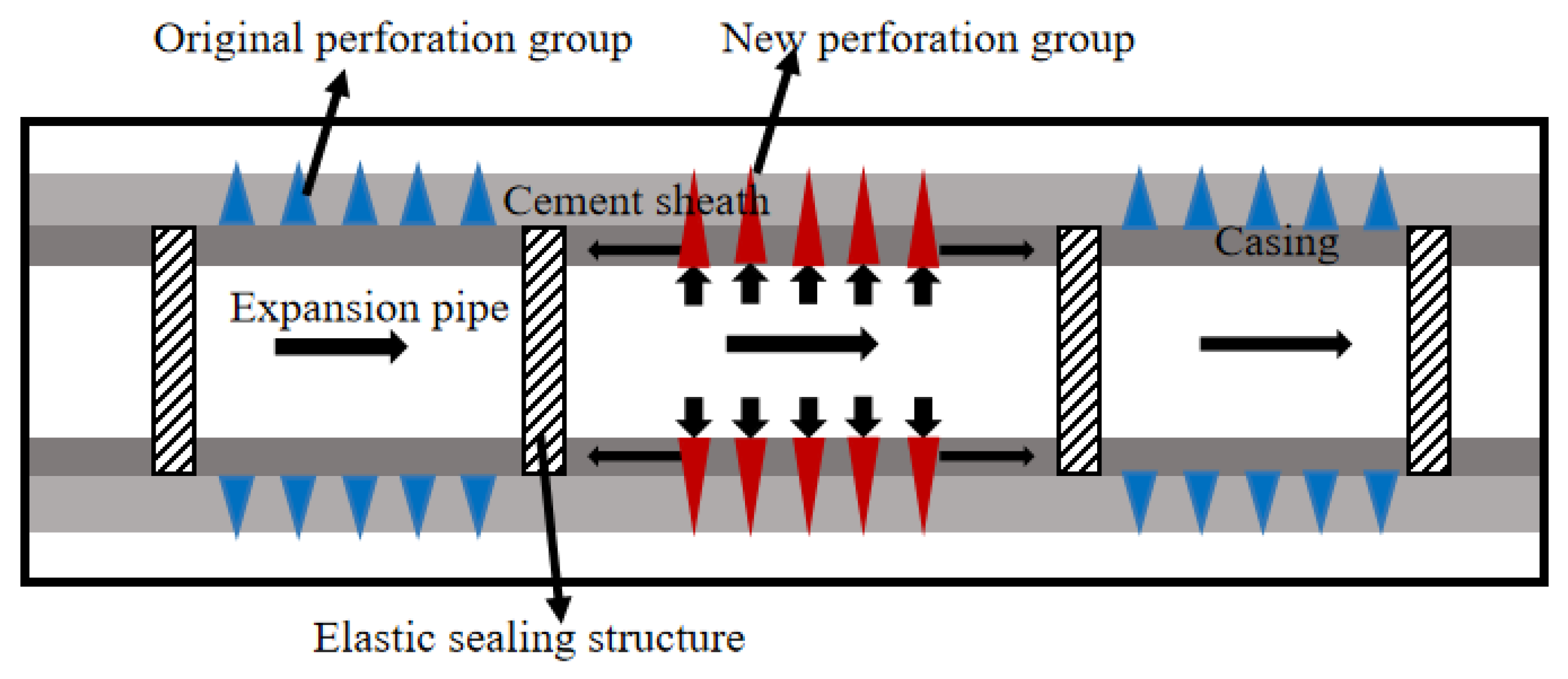



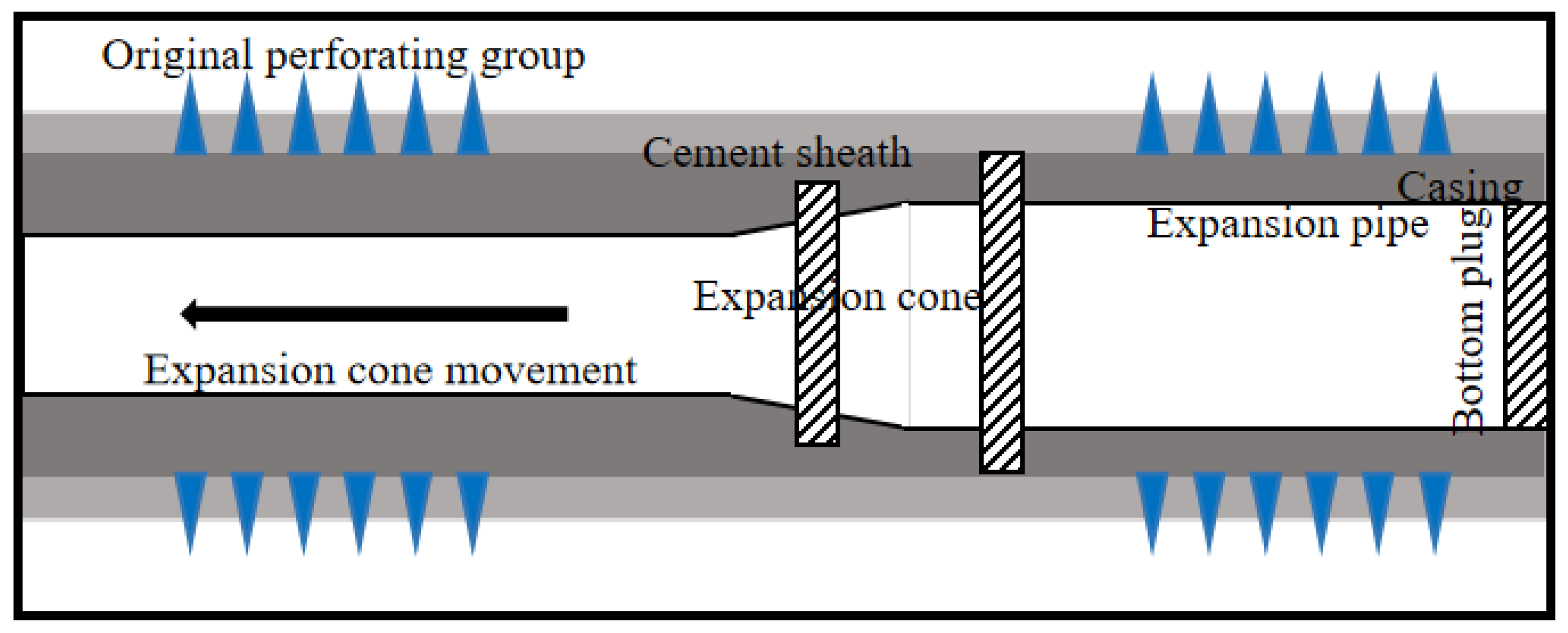
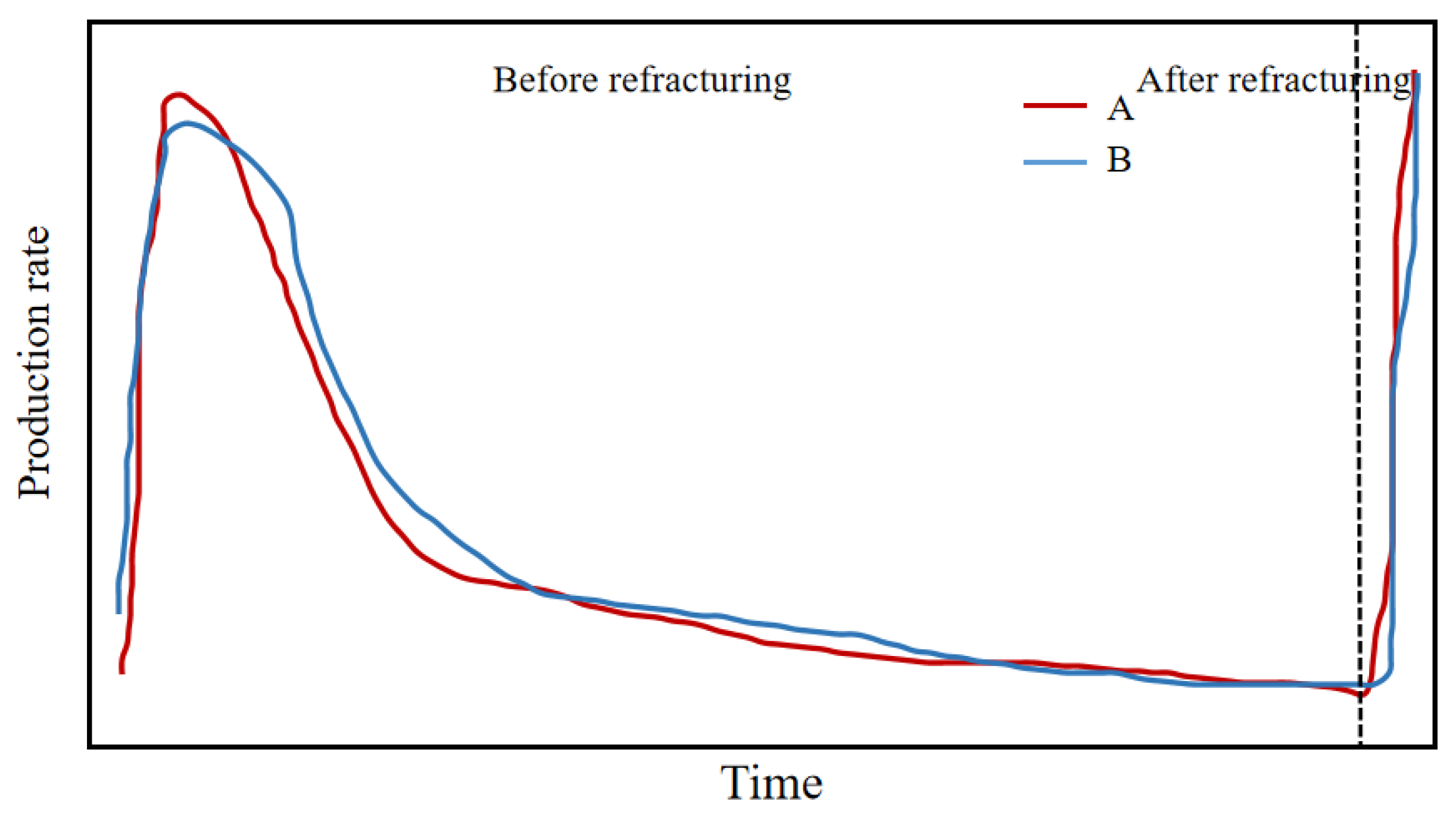
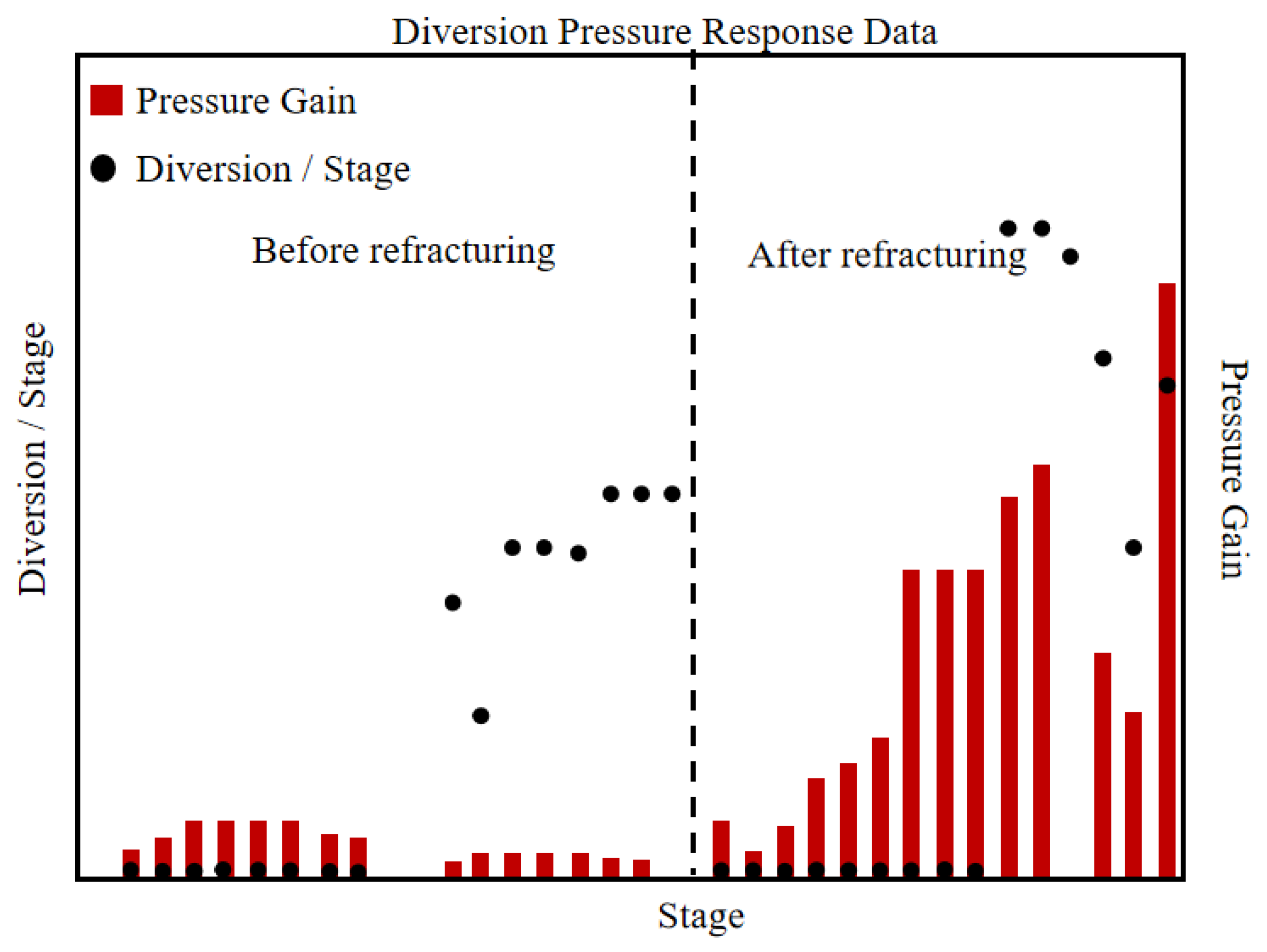
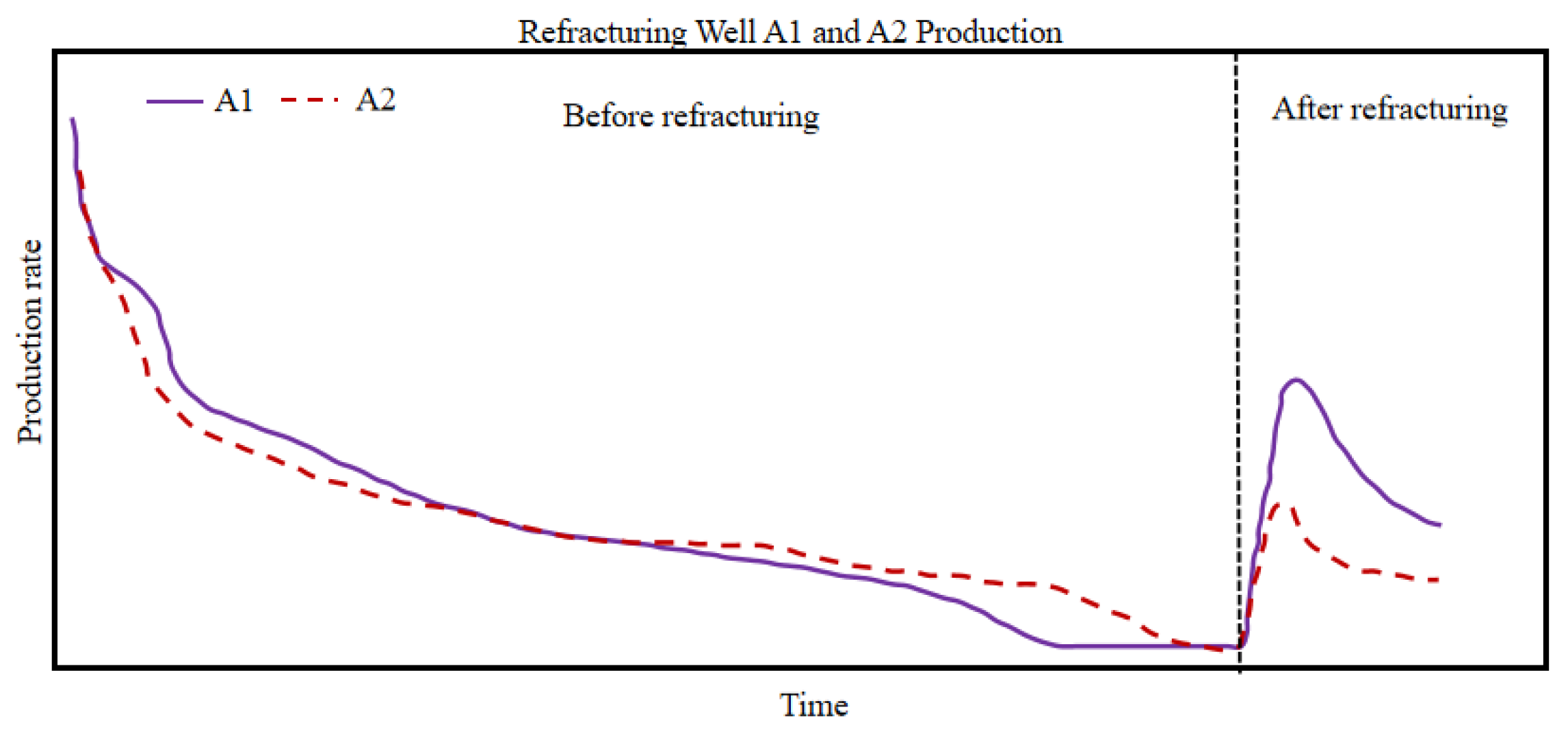




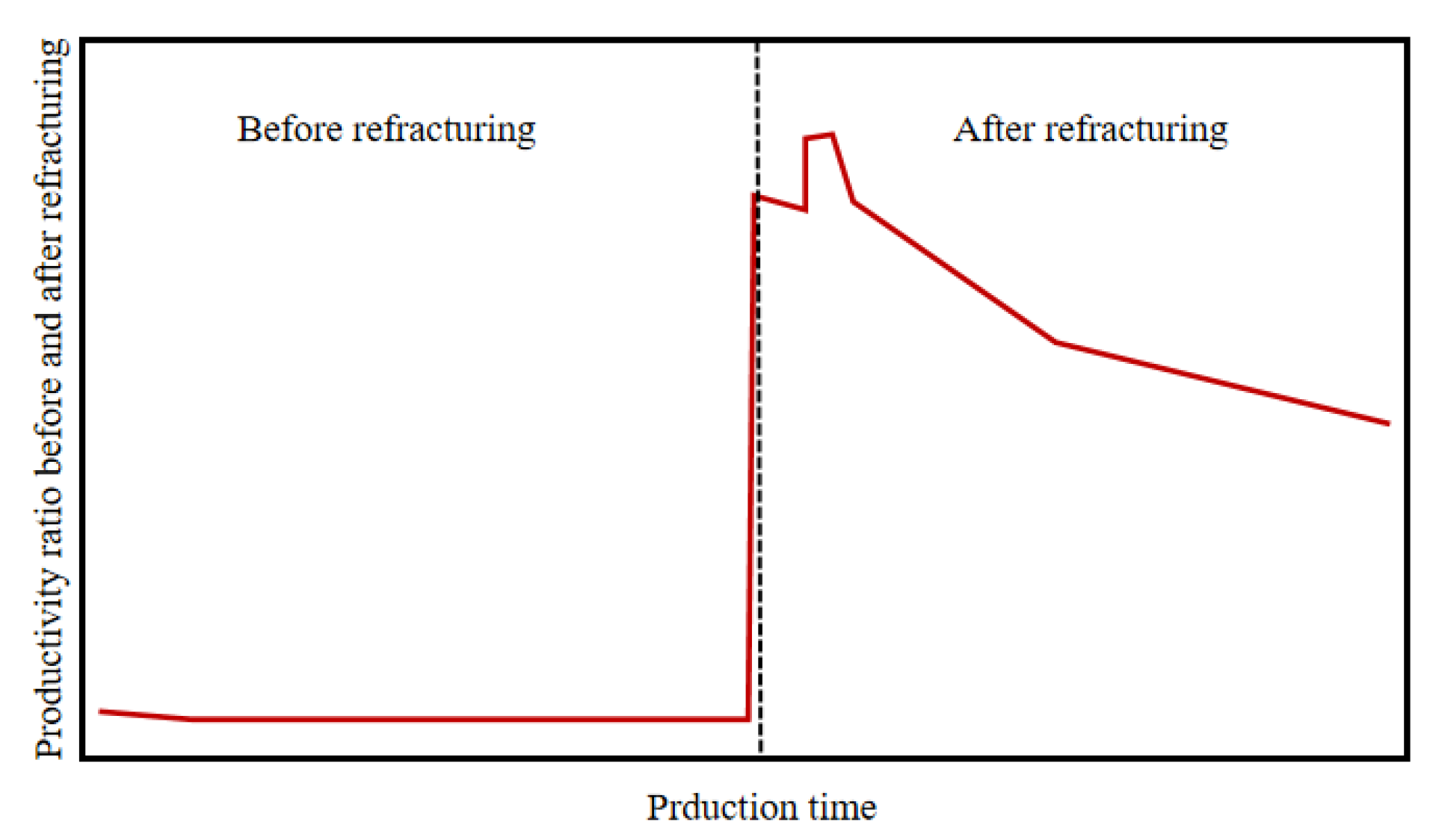


| Refracturing Technique | Process | Applicability | Advantage | Disadvantage | |
|---|---|---|---|---|---|
| General temporary plug refracturing | By adding temporary plugging balls or temporary plugging agents, the fracturing fluid and proppant are forced to enter different fracture clusters. | When utilizing the original wellbore to carry out general repeat fracturing, the purpose is to effectively transform the newly drilled clusters in the primary fracturing cluster or between fractures. | Low technical cost and simple process. | It is difficult to precisely control the temporary plugging location, resulting in significant differences in the construction effects. The average sanding intensity and fluid intensity of repeat fracturing are generally comparable to those of the first fracturing. | |
| Mechanical isolation and refracturing technology | “Nested casing” refracturing | A small-sized casing is inserted into the original wellbore for cementing, and the perforations of the primary fracturing are mechanically sealed off. After a new channel is formed inside the wellbore, segmented perforation fracturing is performed again with the same steps as the primary transformation. | For horizontal well sections, small casings are inserted for cementing, while the original casing is still used in vertical well sections. | It can effectively control the flow direction of the fluid and accurately target areas that have not been successfully fractured during the initial fracturing operation. | The cost is relatively high, and the construction process is complex. Compared to the initial fracturing, the average sand concentration and fluid intensity for repeated fracturing generally increase by 100%, while the stage spacing and cluster spacing are typically reduced by 40% to 50%. Additionally, the construction flow rate is limited by the reduced wellbore diameter b0y approximately 50%. |
| Expandable liner refracturing of wellbore | After inserting the expandable liner into the position which needs to be sealed off, high-pressure fluid is pumped through the wellhead to move the expansion cone and cause the liner to expand. The external sealing device of the liner is seated on the casing, forming a mechanical isolation and seal. | For repeated fracturing operations, there is an issue with chemical temporary plugging agents being unable to control the flow direction of the fracturing fluid. | |||
| Slimhole refracturing technology process | Inserting a liner into the original wellbore and combining a packer and a sliding sleeve for repeated fracturing operations. | It is suitable for both open-hole and cased-hole completions. | |||
Disclaimer/Publisher’s Note: The statements, opinions and data contained in all publications are solely those of the individual author(s) and contributor(s) and not of MDPI and/or the editor(s). MDPI and/or the editor(s) disclaim responsibility for any injury to people or property resulting from any ideas, methods, instructions or products referred to in the content. |
© 2024 by the authors. Licensee MDPI, Basel, Switzerland. This article is an open access article distributed under the terms and conditions of the Creative Commons Attribution (CC BY) license (https://creativecommons.org/licenses/by/4.0/).
Share and Cite
Xu, L.; Wang, D.; Liu, L.; Wang, C.; Zhu, H.; Tang, X. Review of Shale Oil and Gas Refracturing: Techniques and Field Applications. Processes 2024, 12, 965. https://doi.org/10.3390/pr12050965
Xu L, Wang D, Liu L, Wang C, Zhu H, Tang X. Review of Shale Oil and Gas Refracturing: Techniques and Field Applications. Processes. 2024; 12(5):965. https://doi.org/10.3390/pr12050965
Chicago/Turabian StyleXu, Liru, Dajiang Wang, Lizhi Liu, Chen Wang, Haiyan Zhu, and Xuanhe Tang. 2024. "Review of Shale Oil and Gas Refracturing: Techniques and Field Applications" Processes 12, no. 5: 965. https://doi.org/10.3390/pr12050965





